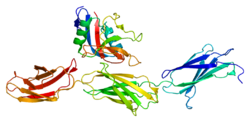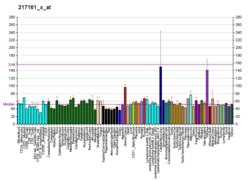Aggrecan (ACAN), also known as cartilage-specific proteoglycan core protein (CSPCP) or chondroitin sulfate proteoglycan 1, is a protein that in humans is encoded by the ACAN gene.[5] This gene is a member of the lectican (chondroitin sulfate proteoglycan) family. The encoded protein is an integral part of the extracellular matrix in cartilagenous tissue and it withstands compression in cartilage.
Aggrecan is a proteoglycan, or a protein modified with large carbohydrates; the human form of the protein is 2316 amino acids long and can be expressed in multiple isoforms due to alternative splicing.[5] Aggrecan was named for its ability to form large aggregates in the cartilage tissue (a large aggregating proteoglycan).[6] [7]
Structure
editAggrecan is a high molecular weight (1x106 < M < 3x106) proteoglycan. It exhibits a bottlebrush structure, in which chondroitin sulfate and keratan sulfate glycosaminoglycan (GAG) chains are attached to an extended protein core.[8]
Aggrecan has a molecular mass >2,500 kDa.[9] The core protein (~300 kDa[10]) has around 100 GAG chains attached to it.[11]
Aggrecan consists of two globular structural domains (G1 and G2) at the N-terminal end and one globular domain (G3) at the C-terminal end, separated by a large extended domain (CS) heavily modified with GAGs. (N-G1-G2-CS-G3-C) The two main modifier moieties are themselves arranged into distinct regions, a chondroitin sulfate and a keratan sulfate region.
The three globular domains, G1, G2, and G3 are involved in aggregation, hyaluronan binding, cell adhesion, and chondrocyte apoptosis.
Recent molecular simulations and neutron scattering experiments suggested that aggrecan in aqueous solutions forms two-dimensional aggregates that resemble sheet-like shapes.[7]
Along with type-II collagen, aggrecan forms a major structural component of cartilage, particularly articular cartilage.
The aggrecan family includes other important members such as versican, also named PG-M, neurocan, brevican and the cell surface HA receptor CD44. They are modular proteoglycans containing combinations of structural motifs, such as EGF-like domains, carbohydrate recognition domains (CRD), complement binding protein (CBP)-like domains, immunoglobulin folds and proteoglycan tandem repeats.
Function
editAggrecan is a critical component for cartilage structure and the function of joints.
Functionally, the G1 domain interacts with hyaluronic acid and link protein, forming stable ternary complexes in the extracellular matrix. G2 is homologous to the tandem repeats of G1 and of link protein and is involved in product processing. G3 makes up the carboxyl terminus of the core protein. It enhances glycosaminoglycan modification and product secretion. Aggrecan plays an important role in mediating chondrocyte-chondrocyte and chondrocyte-matrix interactions through its ability to bind hyaluronan.[11]
Aggrecan provides intervertebral disc and cartilage with the ability to resist compressive loads. The localized high concentrations of aggrecan provide the osmotic properties necessary for normal tissue function with the GAGs producing the swelling pressure that counters compressive loads on the tissue. This functional ability is dependent on a high GAG/aggrecan concentration being present in the tissue extracellular matrix.[12] In the disc, aggrecan concentrations peak in a person's twenties, and decline thereafter, with aggrecan degradation products slowly accumulating over the following decades.[13] This causes discs to get stiffer and less resilient with age.
Aggrecan also plays an important role in the organization of the extracellular spaces between neurons in the brain.[14] Through interactions with link protein and tenascins, aggrecan binds to hyaluronan, forming large aggregated complexes at the cell surface.
Clinical significance
editThe synthesis and degradation of aggrecan are being investigated for their roles in cartilage deterioration during joint injury, disease, and aging.
The linker domain between the N-terminal globular domains, called the interglobular domain, is highly sensitive to proteolysis. Such degradation has been associated with the development of arthritis. Proteases capable of degrading aggrecans are called aggrecanases, and they are members of the ADAM (A Disintegrin And Metalloprotease) protein family.[15]
Degenerative joint disease is a leading source of morbidity resulting in significant social and economic impact. Osteoarthritis is characterized by the slow progressive deterioration of articular cartilage and fibrosis of the synovium and joint capsule. Articular cartilage contains up to 10% proteoglycan by weight, most of which is aggrecan, and its loss is an early sign of the disease.
References
edit- ^ a b c GRCh38: Ensembl release 89: ENSG00000157766 – Ensembl, May 2017
- ^ a b c GRCm38: Ensembl release 89: ENSMUSG00000030607 – Ensembl, May 2017
- ^ "Human PubMed Reference:". National Center for Biotechnology Information, U.S. National Library of Medicine.
- ^ "Mouse PubMed Reference:". National Center for Biotechnology Information, U.S. National Library of Medicine.
- ^ a b Doege KJ, Sasaki M, Kimura T, Yamada Y (January 1991). "Complete coding sequence and deduced primary structure of the human cartilage large aggregating proteoglycan, aggrecan. Human-specific repeats, and additional alternatively spliced forms". J. Biol. Chem. 266 (2): 894–902. doi:10.1016/S0021-9258(17)35257-2. PMID 1985970.
- ^ Aspberg A (December 2012). "The different roles of aggrecan interaction domains". The Journal of Histochemistry and Cytochemistry. 60 (12): 987–96. doi:10.1369/0022155412464376. PMC 3527881. PMID 23019016.
- ^ a b Chremos A, Horkay F (September 2023). "Coexistence of Crumpling and Flat Sheet Conformations in Two-Dimensional Polymer Networks: An Understanding of Aggrecan Self-Assembly". Physical Review Letters. 131 (13): 138101. Bibcode:2023PhRvL.131m8101C. doi:10.1103/PhysRevLett.131.138101. PMID 37832020. S2CID 263252529.
- ^ Nap RJ, Szleifer I (November 2008). "Structure and interactions of aggrecans: statistical thermodynamic approach". Biophys. J. 95 (10): 4570–83. Bibcode:2008BpJ....95.4570N. doi:10.1529/biophysj.108.133801. PMC 2576360. PMID 18689463.
- ^ Hascall VC, Sajdera SW (10 October 1970). "Physical properties and polydispersity of proteoglycan from bovine nasal cartilage". The Journal of Biological Chemistry. 245 (19): 4920–30. doi:10.1016/S0021-9258(18)62796-6. PMID 5506265.
- ^ Chandran PL, Horkay F (January 2012). "Aggrecan, an unusual polyelectrolyte: review of solution behavior and physiological implications". Acta Biomaterialia. 8 (1): 3–12. doi:10.1016/j.actbio.2011.08.011. PMC 3226867. PMID 21884828.
- ^ a b Kiani C, Chen L, Wu YJ, Yee AJ, Yang BB (March 2002). "Structure and function of aggrecan". Cell Res. 12 (1): 19–32. doi:10.1038/sj.cr.7290106. PMID 11942407.
- ^ Roughley P, Martens D, Rantakokko J, Alini M, Mwale F, Antoniou J (2006). "The involvement of aggrecan polymorphism in degeneration of human intervertebral disc and articular cartilage". Eur Cell Mater. 11: 1–7, discussion 7. doi:10.22203/eCM.v011a01. PMID 16425147.
- ^ Sivan SS, Wachtel E, Roughley P (2014). "Structure, function, aging and turnover of aggrecan in the intervertebral disc". Biochim. Biophys. Acta. 1840 (10): 3181–9. doi:10.1016/j.bbagen.2014.07.013. PMID 25065289.
- ^ Morawski M, Brückner G, Arendt T, Matthews RT (May 2012). "Aggrecan: Beyond cartilage and into the brain". The International Journal of Biochemistry & Cell Biology. 44 (5): 690–3. doi:10.1016/j.biocel.2012.01.010. PMID 22297263.
- ^ East CJ, Stanton H, Golub SB, Rogerson FM, Fosang AJ (2007). "ADAMTS-5 deficiency does not block aggrecanolysis at preferred cleavage sites in the chondroitin sulfate-rich region of aggrecan". J. Biol. Chem. 282 (12): 8632–40. doi:10.1074/jbc.M605750200. PMID 17255106.
Further reading
edit- Watanabe H, Yamada Y, Kimata K (1998). "Roles of aggrecan, a large chondroitin sulfate proteoglycan, in cartilage structure and function". J. Biochem. 124 (4): 687–93. doi:10.1093/oxfordjournals.jbchem.a022166. PMID 9756610.
- Fosang AJ, Neame PJ, Last K, Hardingham TE, Murphy G, Hamilton JA (1992). "The interglobular domain of cartilage aggrecan is cleaved by PUMP, gelatinases, and cathepsin B". J. Biol. Chem. 267 (27): 19470–4. doi:10.1016/S0021-9258(18)41799-1. PMID 1326552.
- Sandy JD, Flannery CR, Neame PJ, Lohmander LS (1992). "The structure of aggrecan fragments in human synovial fluid. Evidence for the involvement in osteoarthritis of a novel proteinase which cleaves the Glu 373-Ala 374 bond of the interglobular domain". J. Clin. Invest. 89 (5): 1512–6. doi:10.1172/JCI115742. PMC 443022. PMID 1569188.
- Baldwin CT, Reginato AM, Prockop DJ (1989). "A new epidermal growth factor-like domain in the human core protein for the large cartilage-specific proteoglycan. Evidence for alternative splicing of the domain". J. Biol. Chem. 264 (27): 15747–50. doi:10.1016/S0021-9258(18)71537-8. PMID 2789216.
- Kimata K, Barrach HJ, Brown KS, Pennypacker JP (1981). "Absence of proteoglycan core protein in cartilage from the cmd/cmd (cartilage matrix deficiency) mouse". J. Biol. Chem. 256 (13): 6961–8. doi:10.1016/S0021-9258(19)69084-8. PMID 7240256.
- Glumoff V, Savontaus M, Vehanen J, Vuorio E (1994). "Analysis of aggrecan and tenascin gene expression in mouse skeletal tissues by northern and in situ hybridization using species specific cDNA probes". Biochim. Biophys. Acta. 1219 (3): 613–22. doi:10.1016/0167-4781(94)90220-8. PMID 7524681.
- Ilic MZ, Mok MT, Williamson OD, Campbell MA, Hughes CE, Handley CJ (1995). "Catabolism of aggrecan by explant cultures of human articular cartilage in the presence of retinoic acid". Arch. Biochem. Biophys. 322 (1): 22–30. doi:10.1006/abbi.1995.1431. PMID 7574678.
- Valhmu WB, Palmer GD, Rivers PA, Ebara S, Cheng JF, Fischer S, Ratcliffe A (1995). "Structure of the human aggrecan gene: exon-intron organization and association with the protein domains". Biochem. J. 309. 309 (2): 535–42. doi:10.1042/bj3090535. PMC 1135764. PMID 7626017.
- Barry FP, Neame PJ, Sasse J, Pearson D (1994). "Length variation in the keratan sulfate domain of mammalian aggrecan". Matrix Biol. 14 (4): 323–8. doi:10.1016/0945-053X(94)90198-8. PMID 7827755.
- Fosang AJ, Last K, Neame PJ, Murphy G, Knäuper V, Tschesche H, Hughes CE, Caterson B, Hardingham TE (1994). "Neutrophil collagenase (MMP-8) cleaves at the aggrecanase site E373-A374 in the interglobular domain of cartilage aggrecan". Biochem. J. 304. 304 (2): 347–51. doi:10.1042/bj3040347. PMC 1137499. PMID 7998967.
- Fosang AJ, Last K, Knäuper V, Neame PJ, Murphy G, Hardingham TE, Tschesche H, Hamilton JA (1993). "Fibroblast and neutrophil collagenases cleave at two sites in the cartilage aggrecan interglobular domain". Biochem. J. 295. 295 (1): 273–6. doi:10.1042/bj2950273. PMC 1134849. PMID 8216228.
- Korenberg JR, Chen XN, Doege K, Grover J, Roughley PJ (1993). "Assignment of the human aggrecan gene (AGC1) to 15q26 using fluorescence in situ hybridization analysis". Genomics. 16 (2): 546–8. doi:10.1006/geno.1993.1228. PMID 8314595.
- Dudhia J, Davidson CM, Wells TM, Vynios DH, Hardingham TE, Bayliss MT (1996). "Age-related changes in the content of the C-terminal region of aggrecan in human articular cartilage". Biochem. J. 313. 313 (3): 933–40. doi:10.1042/bj3130933. PMC 1217001. PMID 8611178.
- Fülöp C, Cs-Szabó G, Glant TT (1996). "Species-specific alternative splicing of the epidermal growth factor-like domain 1 of cartilage aggrecan". Biochem. J. 319. 319 (3): 935–40. doi:10.1042/bj3190935. PMC 1217878. PMID 8921002.
- Kirschfink M, Blase L, Engelmann S, Schwartz-Albiez R (1997). "Secreted chondroitin sulfate proteoglycan of human B cell lines binds to the complement protein C1q and inhibits complex formation of C1". J. Immunol. 158 (3): 1324–31. doi:10.4049/jimmunol.158.3.1324. PMID 9013976. S2CID 44725378.
- Parkar AA, Kahmann JD, Howat SL, Bayliss MT, Day AJ (1998). "TSG-6 interacts with hyaluronan and aggrecan in a pH-dependent manner via a common functional element: implications for its regulation in inflamed cartilage". FEBS Lett. 428 (3): 171–6. Bibcode:1998FEBSL.428..171P. doi:10.1016/S0014-5793(98)00523-7. PMID 9654129.
- Fosang AJ, Last K, Fujii Y, Seiki M, Okada Y (1998). "Membrane-type 1 MMP (MMP-14) cleaves at three sites in the aggrecan interglobular domain". FEBS Lett. 430 (3): 186–90. Bibcode:1998FEBSL.430..186F. doi:10.1016/S0014-5793(98)00667-X. PMID 9688535.
- "Aggrecan". Learning Center. Sigma-Aldrich Company. Retrieved 2011-10-24.
External links
edit- Aggrecan at the U.S. National Library of Medicine Medical Subject Headings (MeSH)
- Human ACAN genome location and ACAN gene details page in the UCSC Genome Browser.
- Overview of all the structural information available in the PDB for UniProt: P16112 (Human Aggrecan core protein) at the PDBe-KB.
- Overview of all the structural information available in the PDB for UniProt: P07897 (Rat Aggrecan core protein) at the PDBe-KB.







